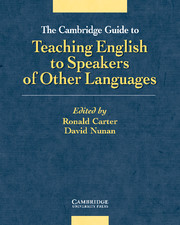Book contents
- Frontmatter
- Contents
- List of figures
- List of abbreviations
- Acknowledgements
- List of contributors
- Introduction
- Chapter 1 Listening
- Chapter 2 Speaking
- Chapter 3 Reading
- Chapter 4 Writing
- Chapter 5 Grammar
- Chapter 6 Vocabulary
- Chapter 7 Discourse
- Chapter 8 Pronunciation
- Chapter 9 Materials development
- Chapter 10 Second language teacher education
- Chapter 11 Psycholinguistics
- Chapter 12 Second language acquisition
- Chapter 13 Bilingualism
- Chapter 14 Sociolinguistics
- Chapter 15 Computer-assisted language learning
- Chapter 16 Observation
- Chapter 17 Classroom interaction
- Chapter 18 English for academic purposes
- Chapter 19 English for specific purposes
- Chapter 20 Assessment
- Chapter 21 Evaluation
- Chapter 22 Syllabus design
- Chapter 23 Language awareness
- Chapter 24 Language learning strategies
- Chapter 25 Task-based language learning
- Chapter 26 Literature in the language classroom
- Chapter 27 Genre
- Chapter 28 Programme management
- Chapter 29 Intercultural communication
- Chapter 30 On-line communication
- Postscript: The ideology of TESOL
- Glossary
- References
- Index
Chapter 25 - Task-based language learning
Published online by Cambridge University Press: 07 September 2010
- Frontmatter
- Contents
- List of figures
- List of abbreviations
- Acknowledgements
- List of contributors
- Introduction
- Chapter 1 Listening
- Chapter 2 Speaking
- Chapter 3 Reading
- Chapter 4 Writing
- Chapter 5 Grammar
- Chapter 6 Vocabulary
- Chapter 7 Discourse
- Chapter 8 Pronunciation
- Chapter 9 Materials development
- Chapter 10 Second language teacher education
- Chapter 11 Psycholinguistics
- Chapter 12 Second language acquisition
- Chapter 13 Bilingualism
- Chapter 14 Sociolinguistics
- Chapter 15 Computer-assisted language learning
- Chapter 16 Observation
- Chapter 17 Classroom interaction
- Chapter 18 English for academic purposes
- Chapter 19 English for specific purposes
- Chapter 20 Assessment
- Chapter 21 Evaluation
- Chapter 22 Syllabus design
- Chapter 23 Language awareness
- Chapter 24 Language learning strategies
- Chapter 25 Task-based language learning
- Chapter 26 Literature in the language classroom
- Chapter 27 Genre
- Chapter 28 Programme management
- Chapter 29 Intercultural communication
- Chapter 30 On-line communication
- Postscript: The ideology of TESOL
- Glossary
- References
- Index
Summary
Introduction
Most approaches to language teaching can be described as ‘form-based’. Such approaches analyse the language into an inventory of forms which can then be presented to the learner and practised as a series of discrete items. There is an assumption that there is a direct relationship between ‘input’ and ‘intake’, that what is presented can be mastered directly and will, as a result of that mastery, become a part of the learner's usable repertoire. But second language acquisition (SLA) research (see Chapter 12) shows quite clearly that there is no such direct relationship between input and intake. If language learning did work in this way, we would reasonably expect learners to acquire language as a series of successive structures and so to build up the language system in an orderly progression, moving from mastery of one sentence form to mastery of the next and so on, until the language was acquired in all its complexity. But this does not happen. Since the work of Corder (1967), Selinker (1972) and other interlanguage theorists, it has been clear that we cannot predict how input will affect the learner's language development. There is clear evidence that intake does not equal input. Effective learning is constrained by natural developmental processes. What is consciously learned is not necessarily incorporated into spontaneous language production.
In contrast to form-based approaches, task-based learning (TBL) involves the specification not of a sequence of language items, but of a sequence of communicative tasks to be carried out in the target language.
- Type
- Chapter
- Information
- Publisher: Cambridge University PressPrint publication year: 2001
- 27
- Cited by



